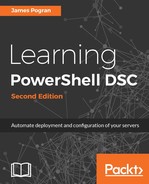PowerShell DSC is released as a feature of PowerShell, so it comes bundled with specific versions of PowerShell that are part of the Windows Management Framework (WMF). The PowerShell DSC version section goes into greater detail about the versions of PowerShell and PowerShell DSC and the available features in each, so we won't get into too much detail here.
The WMF release notes describe DSC in this way:
PowerShell DSC provides a set of Windows PowerShell language extensions, new Windows PowerShell cmdlets, and resources that you can use to declaratively specify how you want your operating system and software environment to be configured. It also provides a means to maintain and manage existing configurations. It supports both an interactive push model, where configurations are executed on target nodes on demand, and a pull model, where a central server manages and distributes configurations.
We won't delve into too much architecture talk here. (The next chapter discusses the architecture and inner workings of DSC in detail.) For now, it is sufficient to say DSC is comprised of both a data file and configuration file that are translated into a text file following the Managed Object Format (MOF). This file is then parsed and executed on the target server, using DSC features that know how to configure the system.
That was a lot of information in a short space, so don't worry if it is a lot to take in at once. We will go over each part as we move on. You don't have to know right away what MOF is or how DSC executes the configuration to use DSC. DSC abstracts all the details away for you. When you get to the point that you need to know these details, DSC still exposes them so you can tweak them under the hood or find out what is really going on.
At a high level, DSC work isn't programming work; it lists how you want a server to look in a special format. The execution of this list is abstracted from the listing, allowing the how to work separately from the why. This is an important concept and really the key to understanding the importance of DSC. Jeffrey Snover, the architect and inventor of PowerShell, explained it best using Star Trek. Captain Picard often used the line "Make it so," and Commander Riker had to figure out how to actually make what the Captain wanted to happen, happen. Captain Picard knew what needed to be done but didn't particularly care how it got done. Commander Riker knew how to get things done but did not concern himself (most of the time) with deciding when and what to do. This separation allowed both officers to be good at their jobs without interfering with each other.
It may be useful to see the following short, complete example of an entire DSC configuration:
configuration BaseServerConfiguration
{
File ExampleTextFile
{
Ensure = 'Present'
Type = 'File'
DestinationPath = 'D:FooProductfoo.txt'
Contents = "this is example text"
}
WindowsFeature DotNet
{
Ensure = 'Present'
Name = 'NET-Framework-45-Core'
}
}
That's it! Sure, there is more to understand and cover, but as we can see here, this is plain PowerShell code that is as readable as any script you've written before, and all it does is list what should be on a system. What this DSC configuration does is ensure that a file is created in the D:FooProduct folder called foo.txt, with the contents this is example text. It then ensures that the .NET framework V4.5 is installed. Yes, .NET 4.5 is most likely already there, but the point of DSC is to describe the state of the target node regardless of what you think might be there. This way, if someone removes .NET 4.5, DSC will ensure that it is installed, thereby maintaining the known good state of the target node.
We will get into this further later, but now you may be asking why it is important to manage the configuration of your systems this way. Read on.
